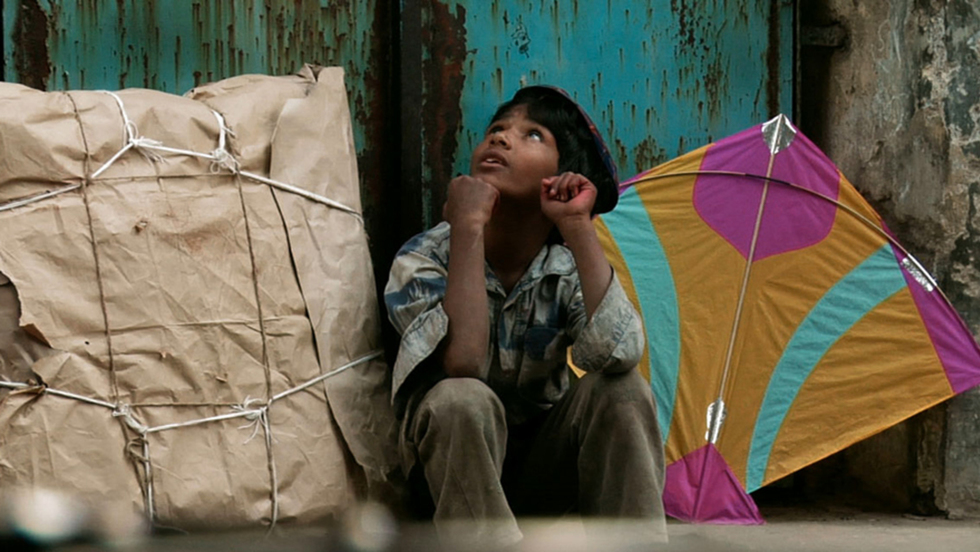
BY PRASHANT BHARGAVA |
Swirling and Soaring Above the Rooftops
In the old city of Ahmedabad, amid India's largest kite festival, a family duels, spins and soars like the countless kites in the skies above. Director Prashant Bhargava on his debut feature Patang (The Kite, TFF 2011), which opens on Friday.

Patang (The Kite) has been a seven-year journey for me, and a work of sheer love.
In India, kite flying is more than a pastime; it’s a fiercely competitive sport that transcends boundaries. On January 14, the city of Ahmedabad is possessed by the spirit of the festival of Uttarayan. At sunrise, rich and poor, Hindu and Muslim, young and old, flood their rooftops with hopes of slicing the line of their neighbor’s kite. One million kites fill the sky. For a city that has endured tremendous religious violence and natural disaster, the kite festival is a vital celebration to move forward. Fly, and all doubts are forgotten; kite flying is meditation in its simplest form. When I first experienced the energy of an entire city dueling kites ferociously, celebrating so freely, I knew I had to make this film. It was a magical, metaphorical backdrop for a family drama.
Here’s an introduction to the kite festival:
Growing up on the south side of Chicago, and as a proud resident of Brooklyn for sixteen years, I knew had to abandon my point of view as an outsider in order to make this film. Inspired by the spiritual energy of the festival, I did three years of research in Ahmedabad, slowly immersing myself in the ways of the old city. I became acquainted with the old city’s unwritten codes of conduct, its rhythms and secrets. I would sit on a street corner for hours at a stretch and just observe. My research team and I would learn the trade secrets from kite makers, chase kites with street kids, befriend the gangsters, dance on the rooftops and gossip with grandmothers. This research was not only the inspiration and foundation for our story, but also the motivation for how we eventually made the film. Our research team shot over 100 hours of research footage, which later became the story boards for the film.
A featurette on the research process:
Preserving the naturalism and beauty discovered during my research guided every decision during filming, from shooting style to crew size to the process with the actors.
90% of our cast were non-actors. We cast locals who were the characters of the script in real life. I would not share the script with them. Rather, I would throw them into real environments with a professional actor. This technique proved magical: the professional actors would have to let go of ‘acting,’ and the non-actors would be led through the arc of each scene.
Priya, the big city girl (played by the beautiful Bollywood actress Sugandha Garg) who arrives with her father, seduces a local kite phenomenon, Bobby (Aakash Mahayera). In a climactic scene (which we shot early), Priya kisses Bobby. That kiss was not only the first kiss for the character, but it was also actor Aakash Mahayera’s first kiss in his life. On and off screen, his infatuation with Sugandha continued. It was truly a coming-of-age story, both for the character and for him personally.
To encourage naturalism and immediacy for the family scenes, I would encourage my cast and crew to just live together. Renowned actress Seema Biswas (Bandit Queen, Water), who plays the widowed sister-in-law, would cook meals for everyone daily. All would eat together, fight and laugh as a family off screen. In the story, Seema’s character plays the nurturing host to her brother-in-law and old friends. These rooftop festival sequences were filmed with a group of non-actors—all of whom had been celebrating and flying kites together for thirty years. Seema was the only professional actor on set. During the shoot, everyone danced, conversed and flew as they always had. Seema, on the other hand, remained in character for six hours at a stretch.

One of the most exhilarating parts of the casting was working with the children. In the script, Chakku, played by the amazing Nawazuddin Siddiqui (Miss Lovely, Peepli Live), befriends a group of kids. We conducted a workshop with twelve children; many of the children had seen adversity in their past, yet their smiles and laughter were pure. The kids never acted; they were always themselves. For Nawazuddin, working with the children was a huge challenge. He had to let go of all his training. He was never Nawaz with them, but rather Chakku on and off the screen.
Throughout, my objective was to have my cast live on screen, rather than act. Every effort was made to allow this to happen, whether it meant shooting in a store while business was being conducted or shooting during the kite festival itself.
Shanker Raman, our director of photography, took a leap of faith, embracing the uncertainty inherent in this process. Both Shanker and I were shooting simultaneously with two small HD cameras. As time progressed, we developed our own rhythm, quietly dancing between the actors’ performances and real environments. Motivated by emotional objectives in contrast to adhering to a specific shot list, there was this madness about the process, as if we were launching and battling kites ourselves. I loved it. The resulting drama that we captured was so pure, intimate and real.
A featurette on the cinematography:
Patang’s joyful message and its cinematic magic developed organically. My desire was for the sense of poetry and aesthetics to be less of an imposed perspective and more of a view that emerged from the pride of the people and place.
I returned to my homes of Brooklyn and Chicago to complete editing the film on my own. Because the scenes were not rehearsed—they were improvised largely with non-actors and shot hand-held in long takes, without the conventional over-the-shoulder or master shots—the edit became a two-year process of distilling and constructing a scripted narrative from 200 hours of documentary-like footage. Just watching the footage took over a month. We would have more than 100 minutes of footage for each minute of screen time. It was a joy in retrospect, but very difficult being in a room by myself.

During the last two months of the edit, I collaborated with editor Joe Klotz (Precious, Rabbit Hole, Junebug) to cut down the two-and-a-half-hour rough cut. We’d go back and forth, revising the larger structure, pacing scenes, preserving the environment and the voice of the film.
Seven years in the making, Patang has been a journey that has inspired and brought together so many. The key theme of resilience of family is reflected by the bonds between all of us who gave our hearts to make the film.
Sharing the film with audiences from the Berlinale to the Tribeca Film Festival, I’m most proud that a film so local and intimate has been embraced across the world as a universal story of family.
Patang releases in theaters in New York, New Jersey and Chicago on June 15, with other cities across North America to follow throughout the summer. For tickets and showtimes, visit www.patang.tv.
Bonus: The filmmakers have invited NYC fans to join them at the film's after party on opening weekend. Your theater ticket grants you access. Click here to find out additional details!
Like PaTang on Facebook, Twitter, and Youtube.
Watch the trailer:

Seven years in the making, Patang is Prashant Bhargava's first feature film. His short film Sangam premiered at the Sundance Film Festival, garnering several awards and distinctions. Prashant started out in the arts as a graffiti artist in his hometown of Chicago. He went on to study computer science at Cornell University and theatrical directing at The Actors Studio MFA program. For the past fifteen years, he has directed and designed commercials, music videos, title sequences and promos in New York. Prashant’s next film is entitled The Highlands.